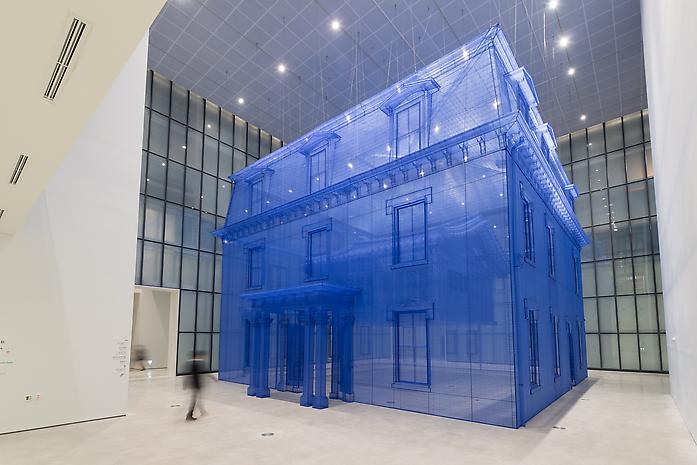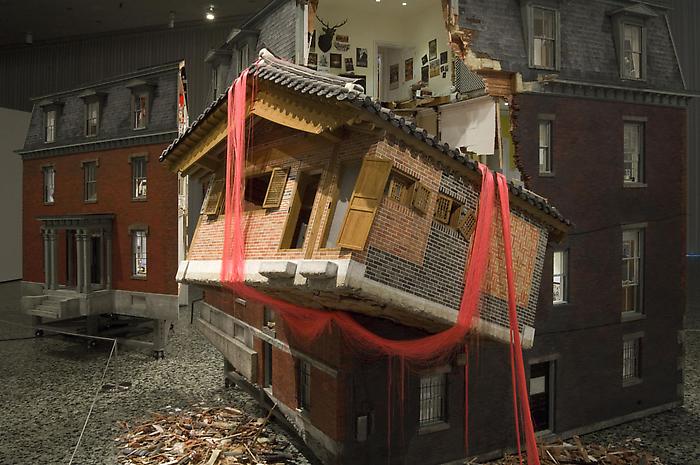Do Ho Suh

Born in the year 1962, integrally impacted by the traditional aesthetics surrounding him in the city of Seoul, South Korea, Do Ho Suh, was nurtured inside of a creative environment by his father, Suh Se-ok, who is an established oriental painter throughout his native country, and stated that he made series's of "little marks as a child", being mesmerized by his hands. Here, his schooling was concentrated on collective uniformity, in which all males would shave their heads and be referred to by numbers, as well as surrounded by the crowded environment of Seoul (whose population density was at fifteen million people per square mile in the late 1970's), transforming his notion of a public place to be one of inherent connection between movement and collectivism. His initial post-secondary education was comprised of attending Seoul National University, where he earned his BFA and MFA in Oriental Painting. Subsequently, he fulfilled his term in the mandatory service inside of the South Korean Military (which deeply attempted to instill hierarchical and bellicose values, serving as a parallel to the societal system of the country macrocosmically, and trained each member in manner which would extend them to both their psychological and physical extremes; being a process of dehumanization). This experience immensely developed within his future art practice, in which he would attempt to understand the boundaries of identity, as well as individuality, collectivism, and anonymity. He observes the ways in which individuals converge into a uniform mass, no mater presence of a strive toward differentiation. After his period in the military, he relocated to the United States in order to continue his studies at the Rhode Island School of Design and Yale University. Living as an itinerant human, he is currently in a constant flux between Seoul, New York, and London, however this initial cultural displacement was entirely effectual upon his work technically and conceptually, in which he studies the malleability of space, both metaphorically and tangibly, leading to a focus upon the transitory notion of home. He often manifests this through autobiographical, site-specific architectural structures of transparent mediums such as polyester and silk; wall fabric that he may transfer, and carry home with him all the time, "like a snail", through deconstruction and reassembling in a new location.The artist has exhibited at the following locations: London Serpentine Gallery (2002), Storefront for Art and Architecture (2010), Seattle Art Museum, Baltimore Museum of Art, Korean Artsonje Center, Museum of Modern Art, 49th Venice Biennial, Whitney Museum of Art, and the Walker Art Center.
Suh externalized an uncertainty towards what he is searching for, due to the fact that he observed that what possesses matter is the process, for all that exists is the present moment in which you are breathing - through this, he compared his work to "the shed skin of snakes"; as a residue or byproduct. In his belief that each human being is attempting to understand, he has stated that he accepts that this has presented itself for him, through the vessel of his art practice.

"Home within Home within Home within Home within Home" 2013
National Museum of Modern and Contemporary Art - Seoul, Korea
{a silk, full-scale reproduction of the artist's first address in the Rhode Island, envelopes a suspension of a three-dimensional replica of his childhood home in Seoul, illuminates his experience with displacement and ephermeral borders}

"Fallen Star" 2008
Stuart Collection, University of San Diego, California
{sculptural models, in the scale of 1:5, of his parents' home in Korea, and the American apartment building which held Suh's first U.S. flat, manifesting as a literal "crash of cultures" - he has also created a life-size version of this piece}

"Staircase" 2003
Lehhman Maupin Gallery, New York
{a red, sewn polyester reproduction of Suh's staircase leading to his New York apartment, while it initially evokes a sense of his Korean homeland's architecture, which serves as a portrayal of a transitional space; a parallel to his movement between cultures between space and time}

"Who am we?" 1996-2000
Museum of Modern Art, New York
{a grid wallpaper that the artist designed, installed within a void room, comprised of 37,000 portraits, each 1/4", from his high school yearbooks, portrays the colliding relationship between individuality and the collective society, being dense in anonymity - in Korean, "we" is used instead of "I"}

"Rubbing/Loving"
Lehmann Maupin, New York
{just before fleeing his first apartment in New York, Suh covered the entire space in white paper, in order to make rubbings with crayon of the entire structure, documenting the layers of time spent, the work initially is perceived as a drawing, reaching a point in which it visually shifts from two to three dimensional, with areas most concentrated with touch have a darker pigmentation through increased pressure of the utensil - he views the concept of rubbing as one of love, emphasized by the fact that in Korean, there is no differentiation between the characters "l" and "b", so people of this language would see the two words as one}
Videos:
"Fallen Star" - https://youtu.be/jbVAv2AENfI
Segment within "Stories" - http://www.art21.org/videos/segment-do-ho-suh-in-stories
(Art21) - https://youtu.be/lXgg2ACBF2o
"Rubbing/Loving" (Art21) - https://youtu.be/9BpBZsKjvD4
"Blueprint" - https://youtu.be/66gLgKQEu1Q
"Staircase III" - https://youtu.be/xYEF_GXilu8
(Bloomberg, Brilliant Ideas Clip) - https://youtu.be/jbL4jsC0itw
"Gate" - https://youtu.be/_R03tUqKVuw
"Who am we?" - https://youtu.be/6MtFJ6U8gOk